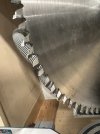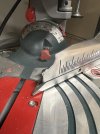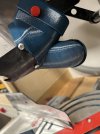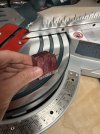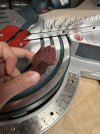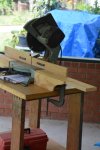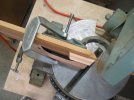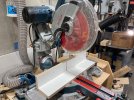So documenting a fairly terrifying event from last weekend for the group as A) a conversation starter re: what went wrong/ better ways to prevent, and B) a PSA of sorts to remind us to all stay on our toes...
FORTUNATELY - I WAS NOT HARMED. I still have all of my fingers, and no carbide bullets lodged anywhere. Definitely woke me up though!
The scenario/ backstory:
I was making a few tool holders/ etc for various frequently used tools to hang on a recently built French-cleat wall, using up various scraps I've had lying around forever. The task at hand was cutting 45 deg miters on some short scraps (the short length being primary culprit here in my view), of purpleheart. The scraps in question were again, very short/ small, (~1.5" square piece of 4/4 stock), so I had a stop block/ backboard hold down in place to keep my hands well clear. my backstop/ hold downs were all friction fit - no mechanical connectors. First cut on piece #1 = no problem/ results as intended. Cut on piece #2 = EXPLOSION, counted my fingers, and patted myself down for holes, (no holes found fortunately).
The 2nd piece grabbed somehow, and apparently shot into the guard around the blade, BREAKING 1 tooth off completely, (physically breaking both the steel and the carbide) and stripping the carbide tooth off of a second, (the blade in question was a freshly sharpened Forrest Chopmaster, so I'm somewhat ruling out the blade as the culprit here), and then continuing it's path and bouncing off the right hand fence of the saw, (Bosch slider), physically breaking, and bending the removable aluminum fence wing).
Other factors - I recently installed a "popular Etsy purchased dust shroud" for the saw - brand/ maker deliberately not named to protect the innocent. That said, this particular dust shroud has a fairly heavy rubber "mouth" to collect *& funnel the dust coming off the back of the blade. I'm thinking that this piece contacted the wood, and lifted it somehow?
So for part A) Group discussion of what I did wrong here - let me have it. Was the culprit the short pieces, or is there validity to the dust shroud contribution? In any case, I'll be removing the shroud on all but 90 degree cuts on standard/ more substantial/ less prone to being lifted. Other thoughts?

FORTUNATELY - I WAS NOT HARMED. I still have all of my fingers, and no carbide bullets lodged anywhere. Definitely woke me up though!
The scenario/ backstory:
I was making a few tool holders/ etc for various frequently used tools to hang on a recently built French-cleat wall, using up various scraps I've had lying around forever. The task at hand was cutting 45 deg miters on some short scraps (the short length being primary culprit here in my view), of purpleheart. The scraps in question were again, very short/ small, (~1.5" square piece of 4/4 stock), so I had a stop block/ backboard hold down in place to keep my hands well clear. my backstop/ hold downs were all friction fit - no mechanical connectors. First cut on piece #1 = no problem/ results as intended. Cut on piece #2 = EXPLOSION, counted my fingers, and patted myself down for holes, (no holes found fortunately).
The 2nd piece grabbed somehow, and apparently shot into the guard around the blade, BREAKING 1 tooth off completely, (physically breaking both the steel and the carbide) and stripping the carbide tooth off of a second, (the blade in question was a freshly sharpened Forrest Chopmaster, so I'm somewhat ruling out the blade as the culprit here), and then continuing it's path and bouncing off the right hand fence of the saw, (Bosch slider), physically breaking, and bending the removable aluminum fence wing).
Other factors - I recently installed a "popular Etsy purchased dust shroud" for the saw - brand/ maker deliberately not named to protect the innocent. That said, this particular dust shroud has a fairly heavy rubber "mouth" to collect *& funnel the dust coming off the back of the blade. I'm thinking that this piece contacted the wood, and lifted it somehow?
So for part A) Group discussion of what I did wrong here - let me have it. Was the culprit the short pieces, or is there validity to the dust shroud contribution? In any case, I'll be removing the shroud on all but 90 degree cuts on standard/ more substantial/ less prone to being lifted. Other thoughts?
Attachments
Last edited:

